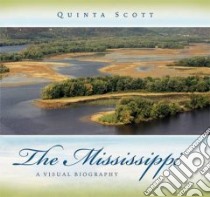The Mississippi - 9780826218407
Un libro in lingua di Quinta Scott edito da Univ of Missouri Pr, 2009
- € 44.60
- Il prezzo è variabile in funzione del cambio della valuta d’origine
Consider the Misi-zibi, the Great River: what natural forces took sixty thousand years to shape, we Americans molded to our needs in three hundred, damaging its wetlands, in some cases, beyond repair. Photographer Quinta Scott has documented the progression of the Mississippi River from its source at Lake Itasca to the Gulf of Mexico, with hundreds of stopping points along the way. In this remarkable volume—the only book to focus on the topography of the whole river and its floodplain—she blends images and text to weave a comprehensive view of the riparian landscape as a living organism and of the effects of human intervention on its natural processes.
Scott began photographing sites along the Mississippi just before the flood of 1993, and her images reflect the sweep of the river's history, from formations from the Pleistocene era to damage left by Hurricane Katrina. Wielding her large-format camera along the river's entire stretch, she captures important sites—places like Bayou de View in the Arkansas “Big Woods,” where the Ivory-billed Woodpecker was sighted in 2004, and the Timbalier Island, a barrier island and hurricane speed bump—that represent both what Americans have done to change the river and our current attempts to restore its damaged ecosystems.
In 200 dramatic color photographs, Scott illustrates the geographical and botanical features of the river and shows how its wetlands were formed by glacial melt and the river's meandering. In accompanying text, she explains how we have changed each site depicted and how we try to manage it and notes the wildlife that occupies it. She describes what is being done to restore the islands and side channels on the Upper Mississippi, forests in the lower alluvial valley, and coastal marshes along the Gulf of Mexico. She also reveals the role of the U.S. Army Corps of Engineers first in changing the river, then in working to restore it, as well as the Corps' relationship with Congress.
No one has ever before attempted such a vast photographic documentation of the Mississippi River, capturing so many sites in all their diversity and complexity while also discussing ongoing geologic processes and human history. This majestic book is nothing less than a natural biography of the Mississippi, showing that, to understand the river and its floodplain today, we must understand the natural processes we have disrupted. It is both a rich documentary source and a fascinating overview for anyone captivated by this quintessential feature of the American landscape.
Informazioni bibliografiche
- Titolo del Libro in lingua: The Mississippi
- Sottotitolo: A Visual Biography
- Lingua: English
- Autore: Quinta Scott
- Editore: Univ of Missouri Pr
- Collana: Univ of Missouri Pr (Hardcover)
- Data di Pubblicazione: 23 Novembre '09
- Genere: PHOTOGRAPHY
- Argomenti : Physical geography Mississippi River Watershed Natural history Mississippi River Valley Nature conservation Mississippi River Valley
- Pagine: 404
- Dimensioni mm: 215 x 279 x 31
- ISBN-10: 0826218407
- EAN-13: 9780826218407


